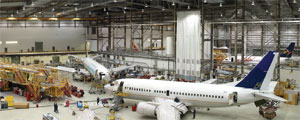
Features
MRO
MRO
Air Canada announced that up to 49% of the new enterprise was for sale.
October 2, 2007 By Carroll McCormick
 Almost seven months to the day after Air Canada converted its technical
Almost seven months to the day after Air Canada converted its technical
services division into a wholly-owned subsidiary, the cash-strapped
airline announced that up to 49% of the new enterprise was for sale –
part of a preemptive strike that did not come soon enough to prevent
the parent company from filing for bankruptcy protection.
Air Canada Technical Services (ACTS) – which is part of the filing for
protection under the Companies’ Creditors Arrangement Act – is the
largest player in Canada’s $3.9-billion aircraft maintenance, repair
and overhaul industry with an estimated 43% of the market. In the last
two years, ACTS has taken advantage of the trend toward increased
outsourcing of maintenance work among the world’s airlines. The
division experienced 12% growth in fiscal year 2000/01.
More
recently,Air Canada became the first airline in North America to offer
nose-to-tail MRO of the Bombardier Regional Jet after ATCS launched a
maintenance line for the CF34-3 engine. This puts the airline in direct
competition with Field Aviation and Avmax Group in Calgary and ExelTech
in Montreal. Air Canada is reported to be at the preliminary stage of
evaluating whether heavy maintenance of its A340 fleet should be
brought in-house, creating new thirdparty opportunities for ATCS.
ACTS is not the only approved maintenance organization (AMO) to spot
and capitalize on global trends – although much of the Canadian
industry remains domestic in scope. Indeed, given the relative size of
its domestic commercial and military markets, the Canadian industry has
done a remarkable job punching above its weight, while showing little
sign of slowing down.
Of the approximately 1,100 AMOs certified
by Transport Canada, more than half employ fewer than five people, and
most rely on the local general aviation community including personal
and flying-school aircraft to put work through the door. While business
appears to be stable, it is assumed that there is not much room for
growth. This could change as smaller business jets such as the Eclipse
500 and Diamond D-Jet enter the field, and opportunities from increased
fractional jet ownership spill over from the US. For now, however,
growth potential remains concentrated among AMOs that specialize in
engine or component maintenance, and the fewer than 100 organizations
that provide full-service maintenance for outside commercial aircraft –
especially in the US, which currently accounts for approximately 50% of
Canada’s third-party business.